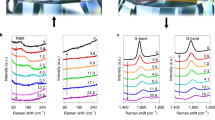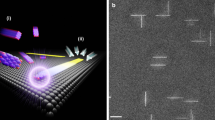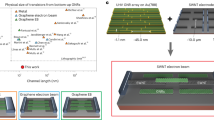Abstract
Graphene nanoribbons have attracted attention because of their novel electronic and spin transport properties1,2,3,4,5,6, and also because nanoribbons less than 10 nm wide have a bandgap that can be used to make field-effect transistors1,2,3. However, producing nanoribbons of very high quality, or in high volumes, remains a challenge1,4,5,6,7,8,9,10,11,12,13,14,15,16,17,18. Here, we show that pristine few-layer nanoribbons can be produced by unzipping mildly gas-phase oxidized multiwalled carbon nanotubes using mechanical sonication in an organic solvent. The nanoribbons are of very high quality, with smooth edges (as seen by high-resolution transmission electron microscopy), low ratios of disorder to graphitic Raman bands, and the highest electrical conductance and mobility reported so far (up to 5e2/h and 1,500 cm2 V−1 s−1 for ribbons 10–20 nm in width). Furthermore, at low temperatures, the nanoribbons show phase-coherent transport and Fabry–Perot interference, suggesting minimal defects and edge roughness. The yield of nanoribbons is ∼2% of the starting raw nanotube soot material, significantly higher than previous methods capable of producing high-quality narrow nanoribbons1. The relatively high-yield synthesis of pristine graphene nanoribbons will make these materials easily accessible for a wide range of fundamental and practical applications.
This is a preview of subscription content, access via your institution
Access options
Subscribe to this journal
Receive 12 print issues and online access
$259.00 per year
only $21.58 per issue
Buy this article
- Purchase on Springer Link
- Instant access to full article PDF
Prices may be subject to local taxes which are calculated during checkout




Similar content being viewed by others
Change history
12 January 2011
In the version of this Letter originally published, the symbols for 'Lithography (ref. 27)' and 'Sonochemical (ref. 1)' in the legend of Figure 4d were the wrong way round. This error has now been corrected in the HTML and PDF versions of the text.
References
Li, X. L. et al. Chemically derived, ultrasmooth graphene nanoribbon semiconductors. Science 319, 1229–1232 (2008).
Wang, X. R. et al. Room-temperature all-semiconducting sub-10-nm graphene nanoribbon field-effect transistors. Phys. Rev. Lett. 100, 206803 (2008).
Wang, X. R. et al. N-doping of graphene through electrothermal reactions with ammonia. Science 324, 768–771 (2009).
Chen, Z. H., Lin, Y. M., Rooks, M. J. & Avouris, P. Graphene nano-ribbon electronics. Physica E 40, 228–232 (2007).
Han, M. Y., Ozyilmaz, B., Zhang, Y. B. & Kim, P. Energy band-gap engineering of graphene nanoribbons. Phys. Rev. Lett. 98, 206805 (2007).
Cresti, A. et al. Charge transport in disordered graphene-based low dimensional materials. Nano Res. 1, 361–394 (2008).
Tapaszto, L., Dobrik, G., Lambin, P. & Biro, L. P. Tailoring the atomic structure of graphene nanoribbons by scanning tunnelling microscope lithography. Nature Nanotechnol. 3, 397–401 (2008).
Datta, S. S., Strachan, D. R., Khamis, S. M. & Johnson, A. T. C. Crystallographic etching of few-layer graphene. Nano Lett. 8, 1912–1915 (2008).
Ci, L. J. et al. Controlled nanocutting of graphene. Nano Res. 1, 116–122 (2008).
Campos, L. C., Manfrinato, V. R., Sanchez-Yamagishi, J. D., Kong, J. & Jarillo-Herrero, P. Anisotropic etching and nanoribbon formation in single-layer graphene. Nano Lett. 9, 2600–2604 (2009).
Campos-Delgado, J. et al. Bulk production of a new form of sp2 carbon: crystalline graphene nanoribbons. Nano Lett. 8, 2773–2778 (2008).
Wu, Z. S. et al. Efficient synthesis of graphene nanoribbons sonochemically cut from graphene sheets. Nano Res. 3, 16–22 (2010).
Jiao, L. Y., Zhang, L., Wang, X. R., Diankov, G. & Dai, H. J. Narrow graphene nanoribbons from carbon nanotubes. Nature 458, 877–880 (2009).
Kosynkin, D. V. et al. Longitudinal unzipping of carbon nanotubes to form graphene nanoribbons. Nature 458, 872–876 (2009).
Zhang, Z. X., Sun, Z. Z., Yao, J., Kosynkin, D. V. & Tour, J. M. Transforming carbon nanotube devices into nanoribbon devices. J. Am. Chem. Soc. 131, 13460–13463 (2009).
Cano-Marquez, A. G. et al. Ex-MWNTs: graphene sheets and ribbons produced by lithium intercalation and exfoliation of carbon nanotubes. Nano Lett. 9, 1527–1533 (2009).
Elías, A. L. et al. Longitudinal cutting of pure and doped carbon nanotubes to form graphitic nanoribbons using metal clusters as nanoscalpels. Nano Lett. 10, 366–372 (2010).
Kim, W. S. et al. Fabrication of graphene layers from multiwalled carbon nanotubes using high d.c. pulse. Appl. Phys. Lett. 95, 083103 (2009).
Colbert, D. T. et al. Growth and sintering of fullerene nanotubes. Science 266, 1218–1222 (1994).
Barinov, A., Gregoratti, L., Dudin, P., La Rosa, S. & Kiskinova, M. Imaging and spectroscopy of multiwalled carbon nanotubes during oxidation: defects and oxygen bonding. Adv. Mater. 21, 1916–1920 (2009).
Stevens, F., Kolodny, L. A. & Beebe, T. P. Kinetics of graphite oxidation: monolayer and multilayer etch pits in HOPG studied by STM. J. Phys. Chem. B 102, 10799–10804 (1998).
Lee, S. M. et al. Defected-induced oxidation of graphite. Phys. Rev. Lett. 82, 217–220 (1999).
Chen, R. J., Zhang, Y. G., Wang, D. W. & Dai, H. J. Noncovalent sidewall functionalization of single-walled carbon nanotubes for protein immobilization. J. Am. Chem. Soc. 123, 3838–3839 (2001).
Dresselhaus, M. S., Dresselhaus, G., Saito, R. & Jorio, A. Raman spectroscopy of carbon nanotubes. Phys. Rep. 409, 47–99 (2005).
Ni, Z. H., Wang, Y. Y., Yu, T. & Shen, Z. X. Raman spectroscopy and imaging of graphene. Nano Res. 1, 273–291 (2008).
Gupta, A. K, Russin, T. J., Gutiérrez, H. R. & Eklund, P. C. Probing graphene edges via Raman scattering. ACS Nano 3, 45–52 (2009).
Lin, Y. M. & Avouris, P. Strong suppression of electrical noise in bilayer graphene nanodevices. Nano Lett. 8, 2119–2125 (2008).
Han, M. Y., Brant, J. C. & Kim, P. Electron transport in disordered graphene nanoribbons. Phys. Rev. Lett. 104, 056801 (2010).
Liang, W. et al. Fabry–Perot interference in a nanotube electronwaveguide. Nature 411, 665–669 (2001).
Todd, K., Chou, H. T., Amasha, S. & Goldhaber-Gordon, D. Quantum dot behavior in graphene nanoconstrictions. Nano Lett 9, 416–421 (2009).
Acknowledgements
This work was supported by Microelectronics Advanced Research Corporation—Materials, Structures, and Devices Center (MARCO-MSD), Intel and the US Office of Naval Research (ONR).
Author information
Authors and Affiliations
Contributions
H.D. and L.J. conceived and designed the experiments. L.J., X.W., G.D. and H.W. performed the experiments and analysed the data. H.D. and L.J. co-wrote the manuscript. All authors discussed the results and commented on the manuscript.
Corresponding author
Ethics declarations
Competing interests
The authors declare no competing financial interests.
Supplementary information
Supplementary information
Supplementary information (PDF 1688 kb)
Rights and permissions
About this article
Cite this article
Jiao, L., Wang, X., Diankov, G. et al. Facile synthesis of high-quality graphene nanoribbons. Nature Nanotech 5, 321–325 (2010). https://doi.org/10.1038/nnano.2010.54
Received:
Accepted:
Published:
Issue Date:
DOI: https://doi.org/10.1038/nnano.2010.54
This article is cited by
-
Exceptionally clean single-electron transistors from solutions of molecular graphene nanoribbons
Nature Materials (2023)
-
Graphene nanoribbons initiated from molecularly derived seeds
Nature Communications (2022)
-
Wearable healthcare smart electrochemical biosensors based on co-assembled prussian blue—graphene film for glucose sensing
Microchimica Acta (2022)
-
Mechanosynthesis of graphene nanoribbons from waste zinc–carbon batteries
Carbon Letters (2022)
-
A review on graphene and its derivatives as the forerunner of the two-dimensional material family for the future
Journal of Materials Science (2022)



